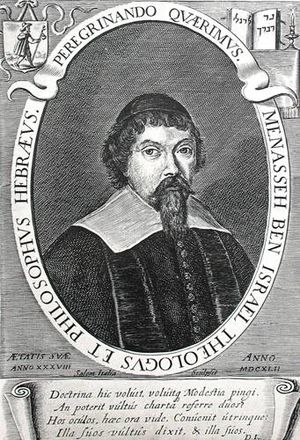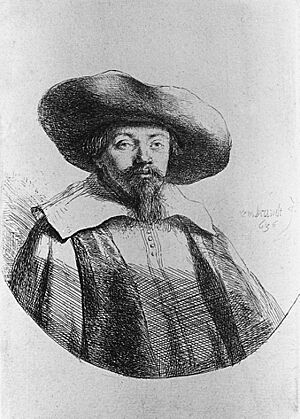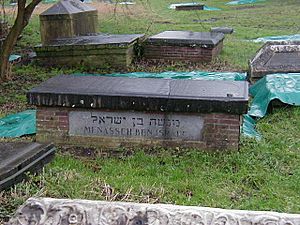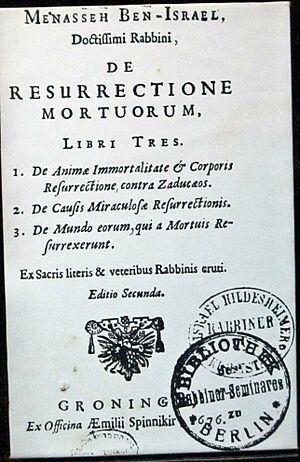Menasseh Ben Israel facts for kids
Quick facts for kids
Menasseh Ben Israel
|
|
|---|---|

Engraved portrait by Salom Italia, 1642
|
|
| Born | 1604 |
| Died | 20 November 1657 (aged 52–53) |
| Resting place | Ouderkerk a/d Amstel |
| Occupation | Rabbi |
| Signature | |
Menasseh Ben Israel (born Manoel Dias Soeiro; 1604 – 20 November 1657) was an important Portuguese rabbi, writer, and diplomat. He was also a Kabbalist, which means he studied Jewish mysticism. Menasseh Ben Israel founded the first Hebrew printing press in Amsterdam in 1626. He is best known for his efforts to help Jewish people return to England after they had been expelled many centuries earlier.
Contents
Life Story

Menasseh Ben Israel was born in La Rochelle, France, in 1604. His family had left Portugal because of the Portuguese Inquisition, a time when Jewish people faced persecution. In 1610, his family moved to the Netherlands. At this time, the Netherlands was fighting for independence from Spanish rule in the Eighty Years' War. Amsterdam became a major center for Jewish life in Europe.
Menasseh became famous not just as a rabbi and writer, but also as a printer. He started the first Hebrew printing press in Holland. One of his first important books was El Conciliador, published in 1632. This book tried to explain parts of the Hebrew Bible that seemed to contradict each other.
In 1644, Menasseh met Antonio de Montezinos, a traveler who had been to the New World (the Americas). Montezinos believed that some Native American tribes were actually descendants of the Ten Lost Tribes of Israel. This idea greatly excited Menasseh. He believed that if Jewish people were spread all over the world, it would be a sign that the messiah was coming soon.
Because of this belief, Menasseh focused on England. Jewish people had been expelled from England in 1290. He wanted to get permission for them to settle there again. He hoped this would help bring about the Messiah's arrival.
Working for Jewish Readmission to England
When Oliver Cromwell and the Commonwealth of England came to power, many people in England, especially Puritans, supported the idea of religious freedom. This made it a good time to discuss allowing Jews back into England.
In 1650, Menasseh published his book, The Hope of Israel. It was first published in Latin and Spanish in Amsterdam. The book talked about Montezinos's claims of finding Jews in the Americas. It also expressed Menasseh's hope that Jews would return to England to speed up the Messiah's coming.
In 1651, Menasseh offered to work for Christina, Queen of Sweden, helping her with Hebrew books. He also met with English diplomats who were impressed by his knowledge. They encouraged him to formally ask for Jewish people to be allowed back into England.
In 1652, The Hope of Israel was translated into English and published in London. This book greatly influenced public opinion in England. It led to many discussions about whether Jews should be allowed to return. Menasseh believed that God had not abandoned the Jewish people, even though they faced challenges. He noted that if one country treated them badly, another would welcome them.
Oliver Cromwell was open to the idea of Jews returning. He believed it would help England's trade and economy. In 1655, Menasseh arrived in London to continue his work. He published a request to Cromwell called Humble Addresses to the Lord Protector.
The Whitehall Conference
In December 1655, Cromwell called the Whitehall Conference. Important leaders, lawyers, and religious thinkers met to discuss if Jews should be allowed back into England. The main outcome was that judges declared there was "no law which forbade the Jews' return to England." This was important because the expulsion had been by a king's order, not a law passed by Parliament.
Even though no official law was passed to allow their return, the door was opened for Jewish people to slowly come back to England. When some people criticized the Jews, Menasseh wrote his important work, Vindiciae judaeorum (1656), to defend them.
Menasseh Ben Israel stayed in England for almost two years. He met many influential people, including scholars and scientists. He worked hard to get written permission for Jews to resettle in England, but he was not successful in getting a formal document.

Death and Burial
In February 1657, Cromwell gave Menasseh a special payment. However, Menasseh died before he could enjoy it. He passed away in November 1657 in Middelburg, Netherlands. He was traveling to bring his son Samuel's body home for burial.
Menasseh Ben Israel is buried in the Beth Haim of Ouderkerk aan de Amstel cemetery. His grave is still there today.
His Writings
Menasseh Ben Israel wrote many books. His major work, Nishmat Hayim, is a Hebrew book about the Jewish idea of reincarnation of souls. It was published by his son Samuel.
The Conciliator was a book written to explain parts of the Bible that seemed to disagree with each other. To do this, Menasseh used many different sources. These included the Talmud (Jewish law and tradition) and classic Jewish Bible explanations. He also quoted early Christian writers and ancient Greek and Latin authors. Written in Spanish in 1632, its main goal was to strengthen the faith of Marranos (Jews who had to hide their religion) in the truth of the Jewish Bible.
Other works he wrote include:
- De Termino Vitae (On the End of Life), written in Latin in 1639.
- De Creatione Problemata XXX (Thirty Problems Concerning Creation), written in Latin in 1635.
- De Resurrectione Mortuorum (On the Resurrection of the Dead), written in Spanish and Latin in 1636.
- De la Fragilidad Humana (On Human Frailty) (1642).
- Thesouros dos dinim (Treasures of Laws), a book about Jewish rituals.
- Piedra gloriosa (Glorious Stone), a book that included four etchings by his friend, the famous artist Rembrandt. These etchings are now kept in the British Museum.
- The Hope of Israel (London 1652).
- Vindiciae Judaeorum (Defense of the Jews) (Amsterdam 1656).
His Family
Menasseh's wife, Rachel, was from the important Abarbanel family. This family was believed to be descendants of King David, and Menasseh was proud of his children's royal ancestry.
Menasseh and Rachel had three children. Sadly, both of his sons died before him. His oldest son, Samuel Abarbanel Soeiro, helped his father with printing and his work in England. He died in 1657. His youngest son, Joseph, died at age 20 in 1650 during a business trip. Menasseh also had a daughter named Gracia, born in 1628. She married Samuel Abarbanel Barboza in 1646 and died in 1690.
See also
- Isaac La Peyrère


